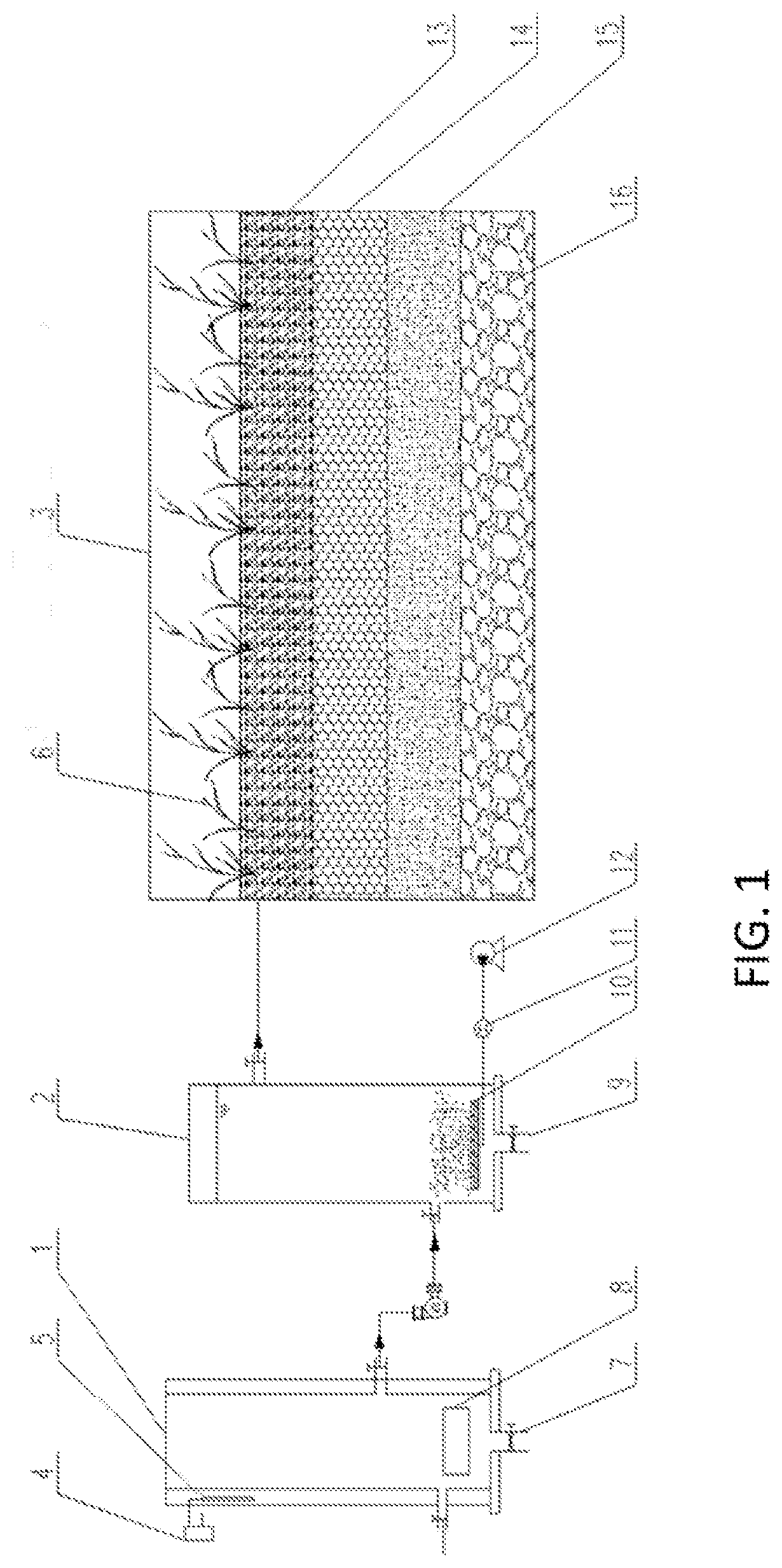Method and device for controlling pollutants in basin water resources cycling utilization in agricultural activity areas
- Summary
- Abstract
- Description
- Claims
- Application Information
AI Technical Summary
Benefits of technology
Problems solved by technology
Method used
Image
Examples
example
Example 1: The Method for Controlling Pollutants in Basin Water Resources Cycling Utilization
[0142]As shown in FIG. 1, provide an acidification tank, an aeration tank and a multi-media constructed wetland connected in sequence. The duckweed and algae salvaged in basin water are crushed, acidified and digested in the acidification tank, then the supernatant from the acidification tank is transported into the aeration tank, and the amount of dissolved oxygen in the aeration tank is maintained at 4-6 mg / L. Water from the aeration tank is mixed with basin water, and then is fed into the multi-media constructed wetland.
[0143]There are four layers of fillers in the multi-media constructed wetland: the first layer of filler at 0-500 cm is a mixed filler of soil and functional biochar, wherein the mixing ratio is 3:7, and the particle size of the filler is 0.10-0.30 cm, and the aquatic plant, reeds, is planted on it; the second layer of filler at 500-1000 cm is a mixed filler of soil, natur...
example [UNK]
Example 2˜18
[0144]Implementing the method for controlling pollutants in basin water resources cycling utilization in agricultural activity areas through the acidification tank, aeration tank and the multi-media constructed wetland, in the same manner as in Example 1, with the differences are shown in Table 1 below.
TABLE 1ExampleDifferences fromExample 1 (the substance and order numberrelated to the ratio is the same as those in Example 1)Example 2The filler in first layer is soilExample 3The mixing ratio in the first layer of filler is 1:1Example 4The particle size of the filler in first layer is 0.01-0.08 cmExample 5The particle size of the filler in first layer is 5-30 mmExample 6The second layer of filler is soil and limestone in original proportionExample 7The second layer of filler is soil and natural zeolite in original proportionExample 8The mixing ratio in the second layer of filler is 1:1:2Example 9The particle size of the filler in second layer is 0.01-0.05 cmExample 10The...
experimental example
[0145]The effects of the pollutant control methods in Examples 1˜18 are evaluated by measuring the content of heavy metals, CODCr, total phosphorus, total nitrogen and pH in the water before and after the treatment. The results are shown in Table 2.
[0146]The water used for evaluation is collected from river water. SnCl4, Zn(NO3)2, biogas slurry, Na3PO4 and NaNO3 are added to water, so that the concentration of Sn in water is 5.23 mg / L, the concentration of Zn is 6.88 mg / L, and the total content of P is 3.36 mg / L, the total content of N is 4.57 mg / L, the concentration of CODCr is 124 mg / L, and the pH value is 7.28. The treated water is fed directly into the constructed wetland with the inflowing rate of 2.5 L / min, and the outflowing rate is 2.5 L / min. The treatment time is 12 h, and the water quality is measured after 12 h.
TABLE 2ExampleSnZnCODCrTotal PTotal Nnumber(mg / L)(mg / L)(mg / L)(mg / L)(mg / L)pHExample11.201.81602.072.357.14Example21.452.191482.462.547.11Example31.251.92682.202.687...
PUM
 Login to View More
Login to View More Abstract
Description
Claims
Application Information
 Login to View More
Login to View More - R&D
- Intellectual Property
- Life Sciences
- Materials
- Tech Scout
- Unparalleled Data Quality
- Higher Quality Content
- 60% Fewer Hallucinations
Browse by: Latest US Patents, China's latest patents, Technical Efficacy Thesaurus, Application Domain, Technology Topic, Popular Technical Reports.
© 2025 PatSnap. All rights reserved.Legal|Privacy policy|Modern Slavery Act Transparency Statement|Sitemap|About US| Contact US: help@patsnap.com

